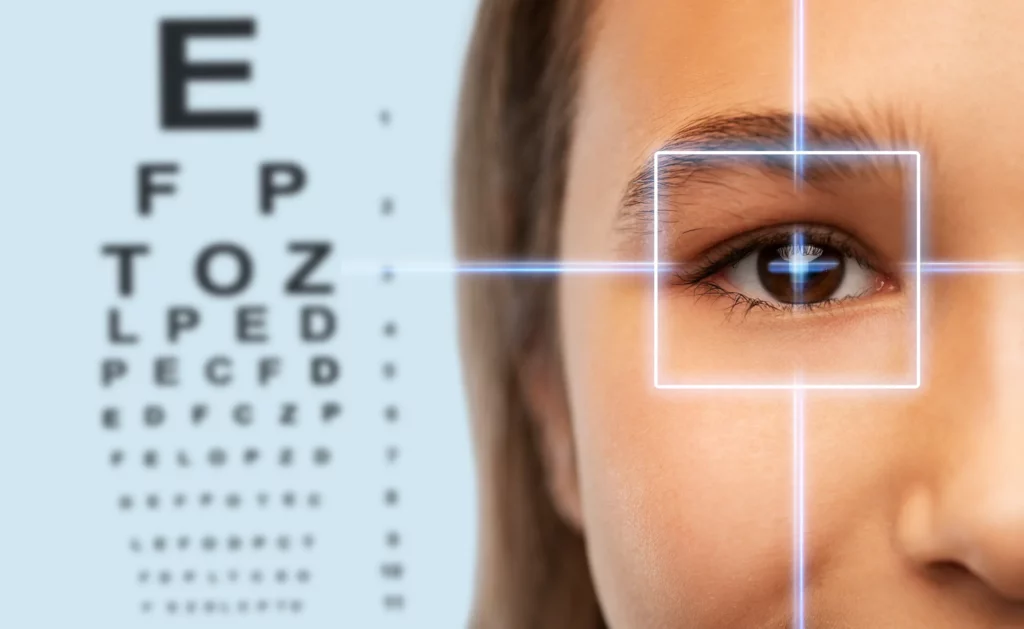LASIK surgery is a remarkable procedure that has improved the vision of many people. But sometimes, the first LASIK surgery may not provide perfect results. That’s where a LASIK enhancement comes in. They are like a second attempt to help people achieve the best vision possible.
Contents
What Are LASIK Enhancements?
LASIK enhancements are essentially follow-up LASIK surgeries. They’re done to fine-tune the vision after the initial LASIK procedure. Sometimes, even after LASIK surgery, a person’s vision might not be as clear as expected. LASIK enhancements address this issue, offering an opportunity to further correct the vision and get closer to the desired visual outcome. They serve as a second chance to achieve the goal of optimal vision.
When Is LASIK Enhancement Needed?
 LASIK touch-up becomes a consideration when the initial LASIK procedure doesn’t yield the desired results, or when changes occur over time that affect the quality of vision.
LASIK touch-up becomes a consideration when the initial LASIK procedure doesn’t yield the desired results, or when changes occur over time that affect the quality of vision.
Here are some instances when LASIK enhancement might be necessary:
- Incomplete Correction: If the initial LASIK surgery doesn’t fully correct the vision problem, an enhancement could provide further refinement.
- Vision Regression: In some cases, the eyes might gradually return to their original state over a period, leading to diminished vision clarity. A LASIK enhancement can rectify this regression.
- Natural Changes: As we age or due to other factors, our vision can naturally alter. A LASIK enhancement may be required in such instances to maintain optimal vision.
Typically, a period of 3 to 6 months is allowed after the original LASIK surgery before considering an enhancement. This timeframe helps ensure the eyes have fully healed and that the vision has stabilized, providing a clearer picture of whether an enhancement is necessary.
Ultimately, the decision to pursue a LASIK touch-up should be made in consultation with your eye doctor.
Determining Eligibility for LASIK Enhancement
 The decision to proceed with a LASIK enhancement isn’t automatic. A thorough eye examination is required first. During this assessment, your ophthalmologist will check several factors to confirm whether you’re a suitable candidate for a LASIK enhancement.
The decision to proceed with a LASIK enhancement isn’t automatic. A thorough eye examination is required first. During this assessment, your ophthalmologist will check several factors to confirm whether you’re a suitable candidate for a LASIK enhancement.
These factors include:
- Corneal Thickness: Adequate corneal thickness is vital for successful LASIK enhancement. The cornea must have enough tissue remaining after the initial LASIK surgery to support another procedure.
- Eye Health: General eye health is a critical determinant. Any signs of eye conditions such as glaucoma, cataracts, or retinal problems can affect the decision to proceed with an enhancement.
- Vision Stability: Your vision should be stable before undergoing a LASIK enhancement. That’s why it’s usually recommended to wait for 3 to 6 months after the initial surgery.
Your eye doctor will discuss the potential risks and benefits with you, helping you make an informed decision about whether to proceed with a LASIK enhancement. However, not everyone is eligible for LASIK enhancements. Some circumstances or conditions may prevent you from being a suitable candidate. These include:
- Unstable Vision: If your vision has not stabilized after the initial LASIK surgery, it might be too early for an enhancement. Usually, a waiting period of 3 to 6 months is recommended to ensure that the vision has fully stabilized.
- Severe Dry Eye: If you have severe dry eye syndrome, further laser surgery might exacerbate the condition.
- Certain Systemic Diseases: Certain systemic diseases like uncontrolled diabetes or autoimmune diseases might also make you ineligible for a LASIK enhancement.
The LASIK Touch-Up Procedure
Like the initial LASIK surgery, the enhancement procedure involves stages before, during, and after the operation. Here’s a breakdown:
Before the Procedure
- Consultation: Your ophthalmologist will conduct a thorough examination to determine if you are a suitable candidate for LASIK enhancement.
- Preparation: Prior to the procedure, it’s essential to adhere to all pre-operative instructions provided by your surgeon. This might include discontinuing the use of contact lenses and certain medications.
During the Procedure
 The LASIK enhancement operation follows a similar process to the initial LASIK surgery:
The LASIK enhancement operation follows a similar process to the initial LASIK surgery:
- Anesthetic Drops: Your eye is numbed using anesthetic eye drops to ensure you are comfortable during the procedure.
- Corneal Flap: The surgeon gently lifts the corneal flap created during your initial LASIK procedure. If it can’t be lifted, a new one may be created.
- Cornea Reshaping: A laser is then used to remove a tiny amount of corneal tissue, which reshapes the cornea to improve its focusing ability.
- Flap Repositioning: Once the cornea has been reshaped, the surgeon repositions the corneal flap. It naturally adheres to the eye without the need for stitches.
After the Procedure
The recovery phase after a LASIK enhancement is crucial to ensuring optimal results:
- Rest: After the procedure, you’ll be asked to rest in the clinic for a short while before being allowed to go home.
- Follow-up Appointments: Regular follow-up visits with your ophthalmologist are essential to monitor your progress and identify any potential complications early.
- Adhering to Care Instructions: You must strictly follow all post-operative care instructions, which may include using prescribed eye drops and avoiding strenuous activities for a specified period.
- Vision Improvement: Most people notice an improvement in their vision within a day or two after the procedure. However, your vision may continue to stabilize over several weeks.
What Is The Expected Recovery Time?
The recovery time after a LASIK enhancement procedure is generally comparable to the recovery time following the initial LASIK surgery. However, individual experiences may vary depending on personal healing rates and the specific requirements of the enhancement. Here’s what you can generally expect:
- Day of Surgery: Immediately after the surgery, your vision will likely be blurry. You’ll need someone to drive you home, and you should rest for the rest of the day.
- First Few Days: Most people notice an improvement in their vision within the first few days. However, it’s normal for vision to fluctuate during this time.
- First Week: In the first week, your eyes may feel dry or itchy. It’s essential to avoid rubbing them, even if they feel uncomfortable.
- First Month: By the end of the first month, most of the healing should be complete. However, your vision may still be stabilizing.
- First Three Months: Over the first three months, your vision will continue to stabilize. It’s during this period that your doctor will determine if further enhancements are necessary.
Understanding the Risks of LASIK Enhancement

Like any surgical procedure, LASIK touch-up comes with its own set of potential risks. While the procedure is generally safe, it’s crucial to understand these potential risks and discuss them with your ophthalmologist before deciding on the surgery.
Some potential risks associated with LASIK enhancements include:
- Dry Eye Syndrome: LASIK enhancement, like the original LASIK procedure, can exacerbate dry eye symptoms.
- Flap Complications: Though rare, complications involving the corneal flap could occur during the procedure.
- Vision Issues: There’s a chance of experiencing glare, halos, or double vision post-surgery.
- Regression: Some patients may experience a regression of vision correction over time.
- Loss of Best-Corrected Vision: In rare cases, you may not see as clearly after surgery, even with glasses or contact lenses.
It’s important to note that advancements in technology and surgical techniques have significantly reduced these risks. Still, every individual is unique, and outcomes can vary.
Cost of LASIK Enhancement in Delhi
The cost of a LASIK enhancement can vary significantly depending on a range of factors, including your location, the specific requirements of the enhancement, and your surgeon’s expertise.
In some cases, if the enhancement is performed within a certain timeframe after the original surgery, the clinic may offer it at a reduced rate or even free of charge. However, this is subject to the terms of your original LASIK surgery agreement.
As a general estimate, LASIK surgery in India ranges from INR 25,000 to INR 1,00,000 per eye. Given this, LASIK enhancements could also fall within a similar range, although some clinics may offer a reduced rate for enhancements if they are performed within a specific timeframe after the initial procedure.
Conclusion
While LASIK enhancements provide an effective solution for refining vision after initial LASIK surgery, it’s worth noting that other options are available too. Investing in LASIK surgery is a decision that can significantly enhance your quality of life.
At EyeMantra, we offer the most advanced LASIK options including PRK, Femto Lasik, SMILE surgery, Standard LASIK, ICL, and Contoura vision. If you have any questions on Lasik surgery in Delhi, Lasik surgery cost, and Lasik procedure, call us at 9711116605 or email at [email protected].
FAQs
1. How effective is LASIK enhancement?
LASIK enhancements can be highly effective for individuals whose vision did not fully correct with initial LASIK surgery or those whose vision changes significantly over time. Most patients report improved vision after a LASIK enhancement procedure.
2. How many times can you have a LASIK touch-up?
The number of times you can have a LASIK enhancement or touch-up is generally dependent on the thickness of your cornea and how much corneal tissue was removed in the initial surgery. While some patients may undergo LASIK enhancement more than once, it’s important to note that each procedure removes additional corneal tissue. Therefore, your doctor will need to evaluate whether sufficient tissue remains to perform additional enhancements safely.
3. What is the minimum corneal thickness for LASIK enhancement?
The minimum corneal thickness for a LASIK enhancement can vary, but in general, the remaining cornea after the procedure should be at least 250-300 microns thick. This is to ensure the structural integrity of the cornea. The specific thickness requirement may depend on various factors, including the type of laser used.



mexican border pharmacies shipping to usa
https://cmqpharma.online/# buying from online mexican pharmacy
mexico pharmacies prescription drugs
mexican pharmaceuticals online: mexican online pharmacy – mexico drug stores pharmacies
mexican online pharmacies prescription drugs [url=https://foruspharma.com/#]buying prescription drugs in mexico[/url] purple pharmacy mexico price list
medicine in mexico pharmacies: purple pharmacy mexico price list – medication from mexico pharmacy
https://canadapharmast.com/# canadianpharmacymeds com
canadapharmacyonline com: legit canadian online pharmacy – canadian pharmacy meds
mail order pharmacy india: mail order pharmacy india – india online pharmacy
canadian king pharmacy [url=https://canadapharmast.online/#]drugs from canada[/url] reddit canadian pharmacy
safe canadian pharmacies: canadian drug prices – best canadian online pharmacy
https://canadapharmast.com/# precription drugs from canada
reputable mexican pharmacies online [url=https://foruspharma.com/#]mexican pharmacy[/url] mexican border pharmacies shipping to usa
india pharmacy: pharmacy website india – online pharmacy india
pharmacies in mexico that ship to usa: mexican online pharmacies prescription drugs – mexican rx online
https://canadapharmast.online/# canadian pharmacy king reviews
mexican border pharmacies shipping to usa [url=http://foruspharma.com/#]buying from online mexican pharmacy[/url] buying prescription drugs in mexico
mexican rx online: mexico drug stores pharmacies – mexican rx online
https://ciprodelivery.pro/# ciprofloxacin generic
https://clomiddelivery.pro/# how can i get generic clomid without insurance
amoxicillin 250 mg price in india [url=http://amoxildelivery.pro/#]amoxicillin 500mg tablets price in india[/url] buy amoxicillin 500mg usa
Paxlovid over the counter: buy paxlovid online – buy paxlovid online
http://paxloviddelivery.pro/# paxlovid buy
http://amoxildelivery.pro/# 875 mg amoxicillin cost
doxycycline price mexico [url=http://doxycyclinedelivery.pro/#]doxycycline prescription price[/url] buy doxycycline online uk
http://paxloviddelivery.pro/# paxlovid generic
doxycycline 50mg tablets: doxycycline online canada without prescription – doxycycline 10mg
https://paxloviddelivery.pro/# paxlovid cost without insurance
paxlovid cost without insurance [url=http://paxloviddelivery.pro/#]Paxlovid over the counter[/url] п»їpaxlovid
http://doxycyclinedelivery.pro/# doxycycline 100 mg
http://amoxildelivery.pro/# amoxicillin 50 mg tablets
п»їpaxlovid [url=https://paxloviddelivery.pro/#]Paxlovid over the counter[/url] paxlovid for sale
buy paxlovid online: paxlovid cost without insurance – buy paxlovid online
https://amoxildelivery.pro/# buy amoxicillin online uk
http://ciprodelivery.pro/# ciprofloxacin order online
buy paxlovid online [url=https://paxloviddelivery.pro/#]Paxlovid buy online[/url] paxlovid pill
http://clomiddelivery.pro/# how to buy clomid online
paxlovid generic: paxlovid pill – paxlovid covid
https://ciprodelivery.pro/# ciprofloxacin generic
paxlovid generic [url=http://paxloviddelivery.pro/#]п»їpaxlovid[/url] paxlovid covid
http://clomiddelivery.pro/# clomid price
http://ciprodelivery.pro/# cipro online no prescription in the usa
doxycycline price 100mg: order doxycycline online australia – cheapest doxycycline 100mg
http://clomiddelivery.pro/# order cheap clomid
can i purchase cheap clomid without a prescription [url=https://clomiddelivery.pro/#]where can i buy generic clomid without prescription[/url] cheap clomid without insurance
https://paxloviddelivery.pro/# paxlovid for sale
http://doxycyclinedelivery.pro/# where can i buy doxycycline without prescription
doxycycline pills price in south africa [url=https://doxycyclinedelivery.pro/#]doxycycline generic brand[/url] buy doxycycline online without prescription
where can i get amoxicillin: amoxicillin tablet 500mg – can we buy amoxcillin 500mg on ebay without prescription
cipro: ciprofloxacin generic price – cipro 500mg best prices